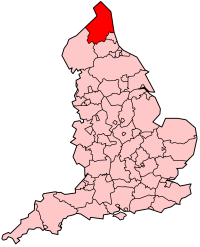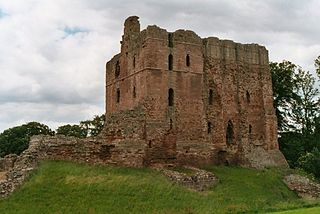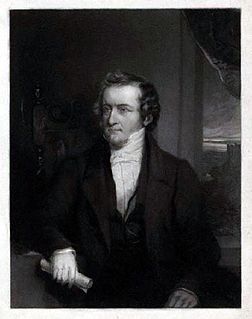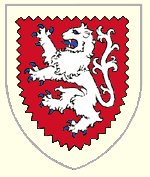Norhamshire was an exclave of County Durham in England. It was first mentioned in 995, when it formed part of the lands of the priory at Lindisfarne. When the lands north of the River Tees were partitioned into Northumberland and County Durham it, along with Bedlingtonshire and Islandshire, stayed under the jurisdiction of Durham despite being north of the River Tyne.

County Durham is a county in North East England. The county town is Durham, a cathedral city. The largest settlement is Darlington, closely followed by Hartlepool and Stockton-on-Tees. It borders Tyne and Wear to the north east, Northumberland to the north, Cumbria to the west and North Yorkshire to the south. The county's historic boundaries stretch between the rivers Tyne and Tees, thus including places such as Gateshead, Jarrow, South Shields and Sunderland.

England is a country that is part of the United Kingdom. It shares land borders with Wales to the west and Scotland to the north-northwest. The Irish Sea lies west of England and the Celtic Sea lies to the southwest. England is separated from continental Europe by the North Sea to the east and the English Channel to the south. The country covers five-eighths of the island of Great Britain, which lies in the North Atlantic, and includes over 100 smaller islands, such as the Isles of Scilly and the Isle of Wight.

The Holy Island of Lindisfarne, also known simply as Holy Island, is a tidal island off the northeast coast of England, which constitutes the civil parish of Holy Island in Northumberland. Holy Island has a recorded history from the 6th century AD; it was an important centre of Celtic Christianity under Saints Aidan of Lindisfarne, Cuthbert, Eadfrith of Lindisfarne and Eadberht of Lindisfarne. After the Viking invasions and the Norman conquest of England, a priory was reestablished. A small castle was built on the island in 1550.
This situation persisted until the Counties (Detached Parts) Act 1844, when it became the Hundred of Norham in Northumberland, to which it had already been united for Parliamentary purposes by the Reform Act 1832. The district originally was the single parish of Norham, which had various townships - the townships became separate civil parishes in 1866. The parishes of Norhamshire were:

The Counties Act 1844, which came into effect on 20 October 1844, was an Act of Parliament of the United Kingdom which eliminated many outliers or exclaves of counties in England and Wales for civil purposes.

The Representation of the People Act 1832 was an Act of Parliament of the United Kingdom that introduced wide-ranging changes to the electoral system of England and Wales. According to its preamble, the Act was designed to "take effectual Measures for correcting divers Abuses that have long prevailed in the Choice of Members to serve in the Commons House of Parliament". Before the reform, most members nominally represented boroughs. The number of electors in a borough varied widely, from a dozen or so up to 12,000. Frequently the selection of MPs was effectively controlled by one powerful patron: for example Charles Howard, 11th Duke of Norfolk, controlled eleven boroughs. Criteria for qualification for the franchise varied greatly among boroughs, from the requirement to own land, to merely living in a house with a hearth sufficient to boil a pot.

In England, a civil parish is a type of administrative parish used for local government, they are a territorial designation which is the lowest tier of local government below districts and counties, or their combined form, the unitary authority. Civil parishes can trace their origin to the ancient system of ecclesiastical parishes which historically played a role in both civil and ecclesiastical administration; civil and religious parishes were formally split into two types in the 19th century and are now entirely separate. The unit was devised and rolled out across England in the 1860s.
- Cornhill-on-Tweed
- Duddo
- Felkington
- Grindon
- Horncliffe
- Loanend
- Longridge
- Norham Mains
- Norham
- Shoreswood
- Thornton
- Twizell

Cornhill-on-Tweed is a small village and civil parish in Northumberland, England about 1 mile (1.6 km) to the east of Coldstream, Scotland. The hamlets of West Learmouth and East Learmouth are located to the south and west of the village respectively.

Duddo is a village and civil parish in Northumberland, about 8 miles (13 km) southwest of Berwick-upon-Tweed.

Horncliffe is a village in the county of Northumberland, England. It lies on the south bank of the River Tweed about 5 miles (8 km) south west of Berwick-upon-Tweed, and about 3 miles (5 km) north east of Norham and is the most northerly village in England.
Elwick was also a (detached) township of the parish of Norham but was associated with Islandshire instead.

Islandshire was an area of Northumberland, England, comprising Lindisfarne or Holy Island, plus five parishes on the mainland.








